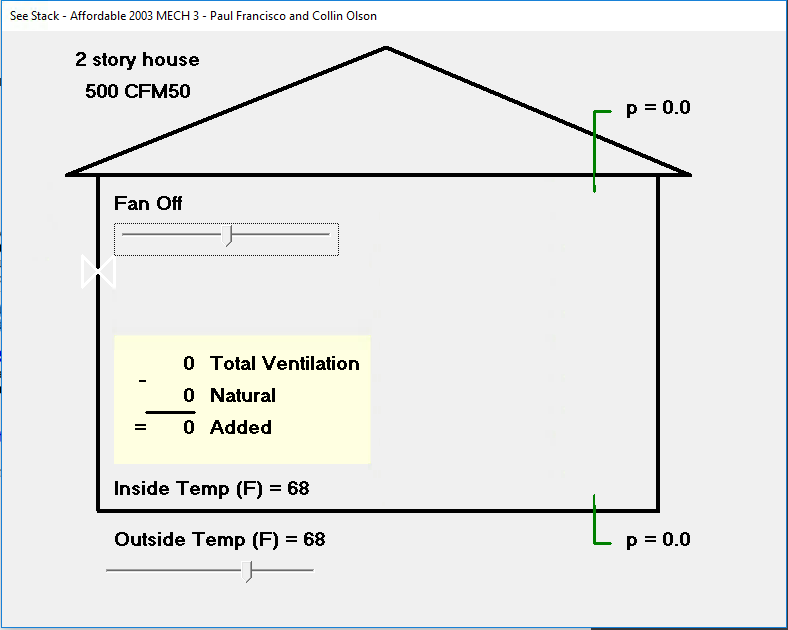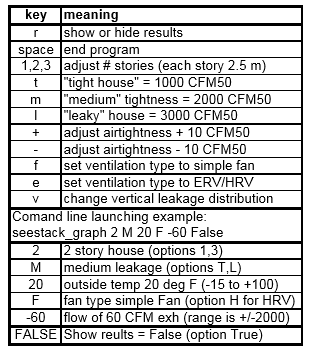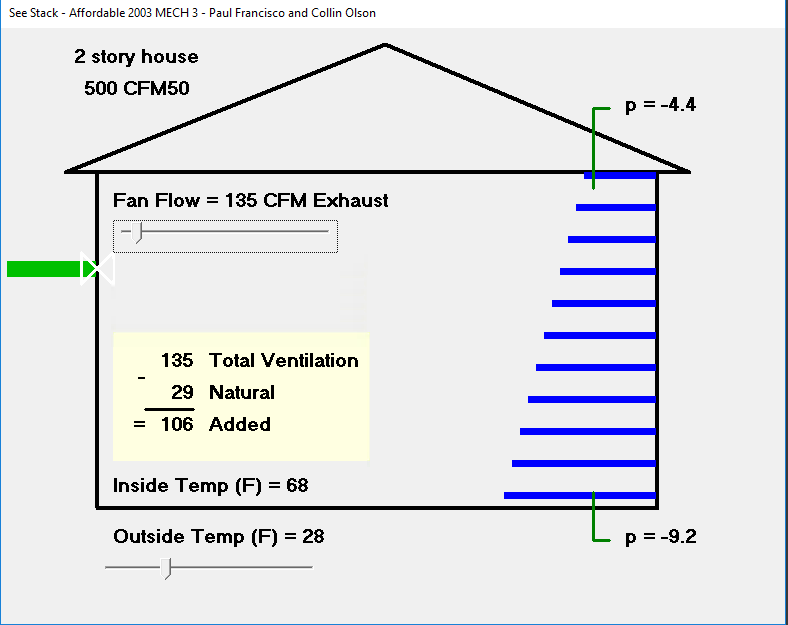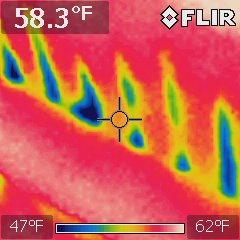Image Credit: Image #1: Peter Yost
Image Credit: Image #1: Peter Yost Larry Palmiter was a much-loved building scientist who died in 2008. Palmiter was a true mentor to many, including Collin Olson.
Image Credit: Image #2: Photo courtesy of Ecotope (http://www.ecotope.com)
In 2003, as part of their presentation (“Ventilation Myths and Misconceptions”) at the Affordable Comfort conference, Collin Olson and Paul Francisco debuted a software tool they developed called SEE STACK. (If you want to experiment with the software, click here to download the executable file and training manual).
“We developed SEE STACK in no small part to demonstrate the Point Five Rule established by Larry Palmiter [see Image #2, below],” said Collin Olson of The Energy Conservatory. “The Point Five Rule states that adding exhaust or supply ventilation only adds about half of its flow to the total ventilation rate of the building under some pretty typical weather conditions.” (For a great detailed discussion on the Point Five Rule in a broader ventilation context, see Ventilation Doesn’t Happen in a Vacuum).
The SEE STACK software shows what happens to the pressure profile of a building as the delta-T (difference between indoor and outdoor temperature) changes and as mechanical ventilation — supply or exhaust — is introduced to small buildings.

The ceiling is dripping
In 2014, I got a call from central Connecticut for a leaking cathedral ceiling and kneewall attic space.
Enclosure details for this story-and-a-half house (28 feet by 32 feet):
- Slab-on-grade foundation
- Kneewall attic space (over the front porch)
- Cathedral roof assembly (from the exterior to the interior): asphalt shingles, #30 felt, SIP with EPS insulation, 6-mil polyethylene, 2×6 tongue-and-groove boards attached to roof timbers spaced 4 feet on center.

- No AC
- Propane-fired direct-vent space heater
- Ventilation system: Balanced HRV servicing mostly the 2nd floor, plus spot exhaust in two bathrooms and laundry room.
In the winter, water was leaking between the tongue-and-groove exposed roof deck boards and into the kneewall attic space.
This sure looked to me as though warm moist air was leaking up into the SIP roof deck, driven by wintertime stack effect, and then condensing and running along the 6-mil poly, leaking through holes back into the cathedral ceiling but also running down the poly to where the poly terminates in the attic knee wall space.
Why now?
But why are these air leaks and the resulting condensation happening now, more than 25 years after the home was built? We confirmed that each SIP was installed with spray foam applied to butt joints as the panels were placed. We hypothesized that continual and cyclical contraction and expansion of the SIP finally resulted in hairline cracks in the spray foam in the butted panel joints.
 I picked a fairly common wintertime delta-T for central Connecticut (40 F°). SEE STACK shows a stack effect at the ceiling plane of positive 2.4 Pa. Note that I have set the airtightness for 500 cfm50, confirmed by a blower door test on the SIP timber-frame home. The blower door also revealed fairly evenly distributed air leaks, resulting in a setting for SEE STACK of evenly distributed air leaks along the vertical profile of the building. (I used the “v” keystroke from the SEE STACK legend above).
I picked a fairly common wintertime delta-T for central Connecticut (40 F°). SEE STACK shows a stack effect at the ceiling plane of positive 2.4 Pa. Note that I have set the airtightness for 500 cfm50, confirmed by a blower door test on the SIP timber-frame home. The blower door also revealed fairly evenly distributed air leaks, resulting in a setting for SEE STACK of evenly distributed air leaks along the vertical profile of the building. (I used the “v” keystroke from the SEE STACK legend above).To confirm all this, we suggested tearing up some roof cladding and inspecting the panel joints, and using a blower door to test the tightness of the SIP seams (using both positive and negative pressure). If this testing proved our theory correct, the solution would be to remove all of the roof cladding and seal the panel joints with topside high-performance pressure-sensitive tape or membrane at all panel joints.
The client balked: he had a pretty new roof and said, “Isn’t there another approach?” That is when I thought of SEE STACK: if the client could stomach the energy costs of an exhaust fan running in the winter to counter the stack effect, could we use SEE STACK to understand the pressure regimes that the home would experience over the winter and to help us correctly size the exhaust fan?
SEE STACK’s predictions were good
So how did we and SEE STACK do? The tables below show that the client’s exhaust fan is altering the pressure profile the same way (or very nearly the same way) as SEE STACK predicted. For the last three years, the client has had no wintertime cathedral ceiling leakage. The client adjusts the exhaust fan based on approximate delta-T, higher fan settings when it is really cold and lower when it is not. (He only operates the fan during the heating season).


What about radon? What about backdrafting?
What other consequences are there when changing the pressure profile of this home with an exhaust fan? We considered two phenomena:
- 1. Radon: The home had never been tested for radon so we ran some three-day tests, using a Siren Safety Series 3 electronic radon test. We got the following info:
- Closed home with HRV off: 8.4 pC/l
- Closed home with HRV on: 2.4 pC/l
- Closed home with HRV and exhaust fan on high: 2.8 pC/l
The client and I were satisfied with these results and the client decided not to conduct longer-term radon testing.
- 2. The direct-vent space heater: We used the model number on the heater unit to confirm that it was rated for negative pressure regimes up to -25 Pa. We also field-tested its performance under the negative pressure regime that the exhaust fan creates. We detected no significant air leakage associated with the through-the-wall-flue, no evidence of backdrafting, and no fuel odors.
A postscript from Collin Olson, one of the two developers of SEE STACK: “The name ‘See Stack’ is descriptive of what the program does. It was also a nod to the show ‘Land of the Lost’ as well as the amazing ‘Sea Stacks’ of the Pacific Northwest near Seattle, where Larry Palmiter and Paul Francisco were at the time.”
In addition to acting as GBA’s technical director, Peter Yost is the Vice President for Technical Services at BuildingGreen in Brattleboro, Vermont. He has been building, researching, teaching, writing, and consulting on high-performance homes for more than twenty years. An experienced trainer and consultant, he’s been recognized as NAHB Educator of the Year. Do you have a building science puzzle? Contact Pete here. You can also sign up for BuildingGreen’s email newsletter to get a free report on avoiding toxic insulation, as well as regular posts from Peter.
Weekly Newsletter
Get building science and energy efficiency advice, plus special offers, in your inbox.

















11 Comments
spray foam
I think there is a lesson here for those who think that a can of spray foam is an effective way to air seal just about anything. But it probably will last through the blower door test.
Jon
I think you may be disingenuous when you say "those who think that a can of spray foam is an effective way to air seal just about anything". There have been recent comments by myself in which I have preferred 1 part (canned) foam over 2 part foam if it's a small area that needs to be covered. It seems to me it's an entirely justifiable notion due to the much more controlled application requirements for doing 2 part foam. Entire homes have been rendered uninhabitable due to two part foam combining in an unsuitable mixture. It's rare but it has happened.
How you move to a rare event but with a highly significant destructive result, to the fact that (I'm assuming here) that people like me think a can of foam can cure all air leaks is just irresponsible. I never said that, nor do I think it. You are attempting to put words in my mouth.
Eric, you can rest assured
Eric, you can rest assured that my comment is not in reference to anything you have written. My opinion is that there should be more use of tape and gaskets.
Jon
I'm having a hard time seeing how your comment could be construed at being directed at anyone.
I misinterpreted what was said.
I stand corrected then and was wrong.
Other lessons are that
Other lessons are that pressure is critical. In this case, for partition moisture management. But also for heat loss/gain, dehumidification, flue draft, radon, etc. Yet there are lots of buildings that inadvertently alter pressure with no regard to the effects.
If it looks like malware...
Malware is at the core of almost every piece of software that offers free download, with no additional information on system requirements, OS platform, version number and other details. I have faith in Greenbuilding Advisor, but I have no knowledge of this company that is offering software in what looks to be the classic computer-infecting strategy. Even if the download won't destroy my computer, it's irresponsible for a good company to adopt the clothing of the hackers, crackers, and spammers. Without any indication of whether it will even run on my computer.
Malware issue
Derek Roff:
GBA would not post a link in which we don't have full confidence. The Energy Conservatory (TEC), which is posting the free download software, SEE STACK, is a reputable long-standing company in the building industry.
The executable file at the heart of SEE STACK has been used by many building scientists for years and I have dowloaded SEE STACK more than once without ill effect.
By the way, SEE STACK is designed to run in a PC environment.
Not surprisingly, when I tried to download Seestack I got got the 404 error.
On another topic I have found that cans of spray foam (or spray paint) that have been sitting around for a long time will work much better after spending a few minutes in the paint can shaker at your local hardware store. Barring that just strap the can onto an old blade of a reciprocal saw. Protect the can from the teeth of the saw or you might open a leak. Spray foam is horrible where you don't want it.
Nils,
Thanks for letting us know about your download problem. Evidently The Energy Conservatory changed the web site address for the free download. I just corrected the link in the first paragraph.
To get the free download, you have to register with The Energy Conservatory site -- but registering is free. Once you've registered (shared your email address), you should be able to download the program. I tested it, and it worked for me.
I was also able to get SeeStack to work with Linux/Wine.
Log in or create an account to post a comment.
Sign up Log in